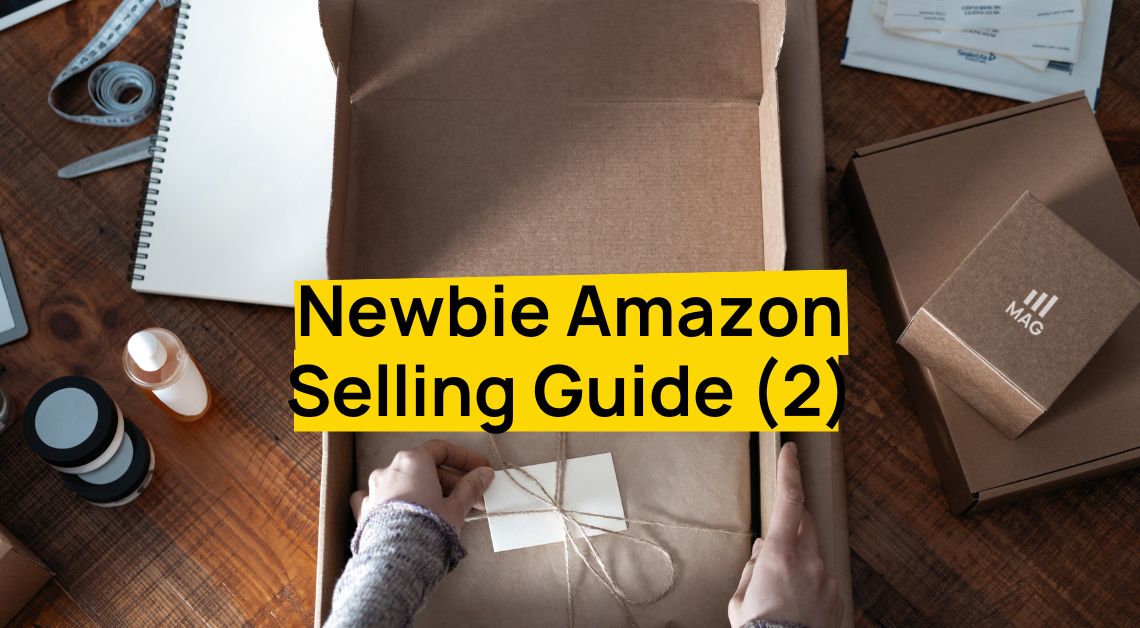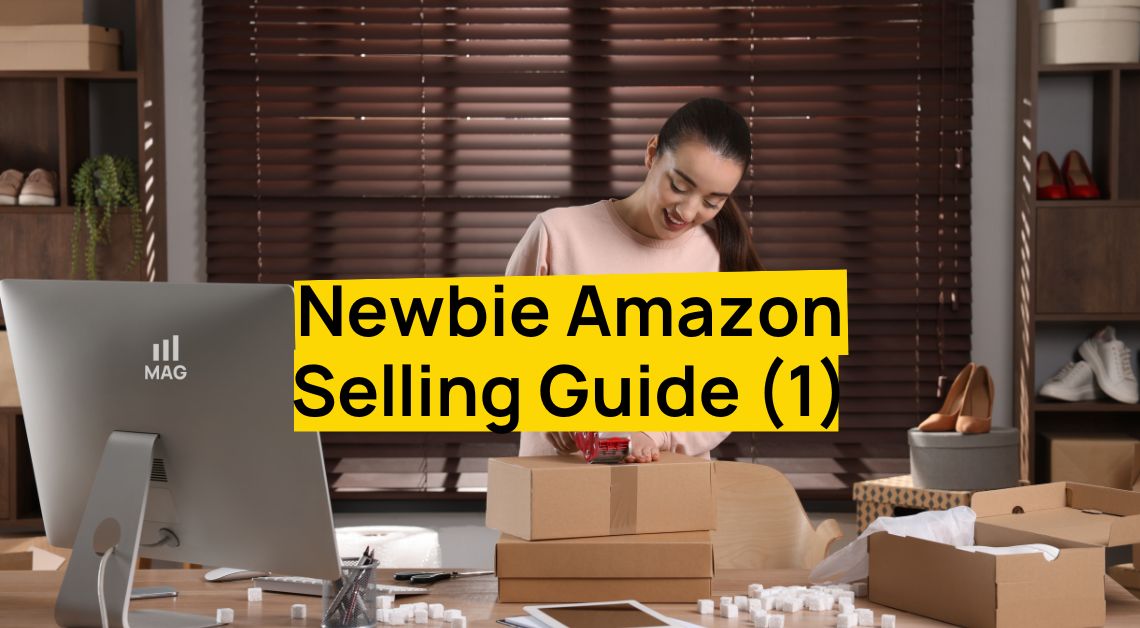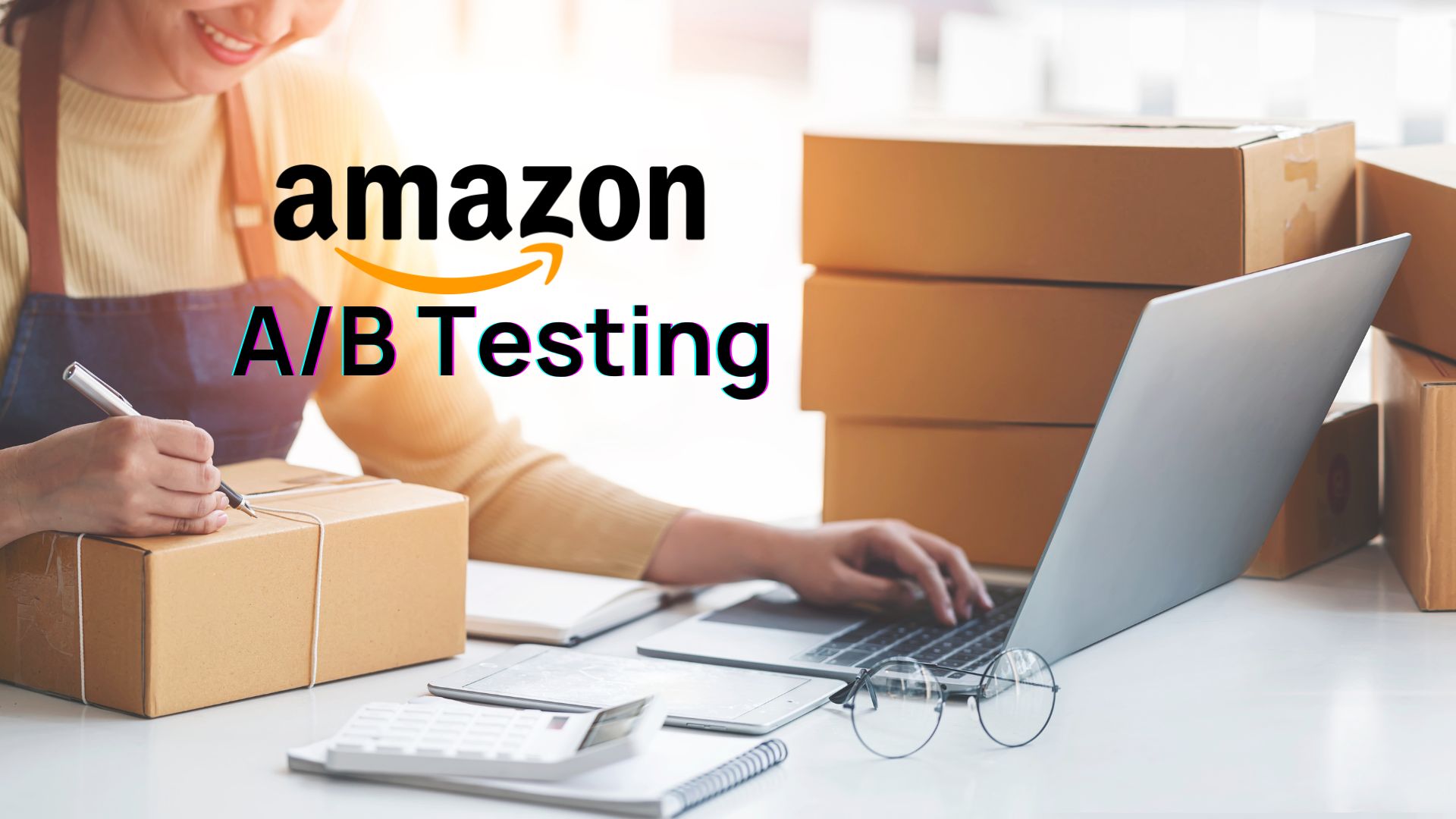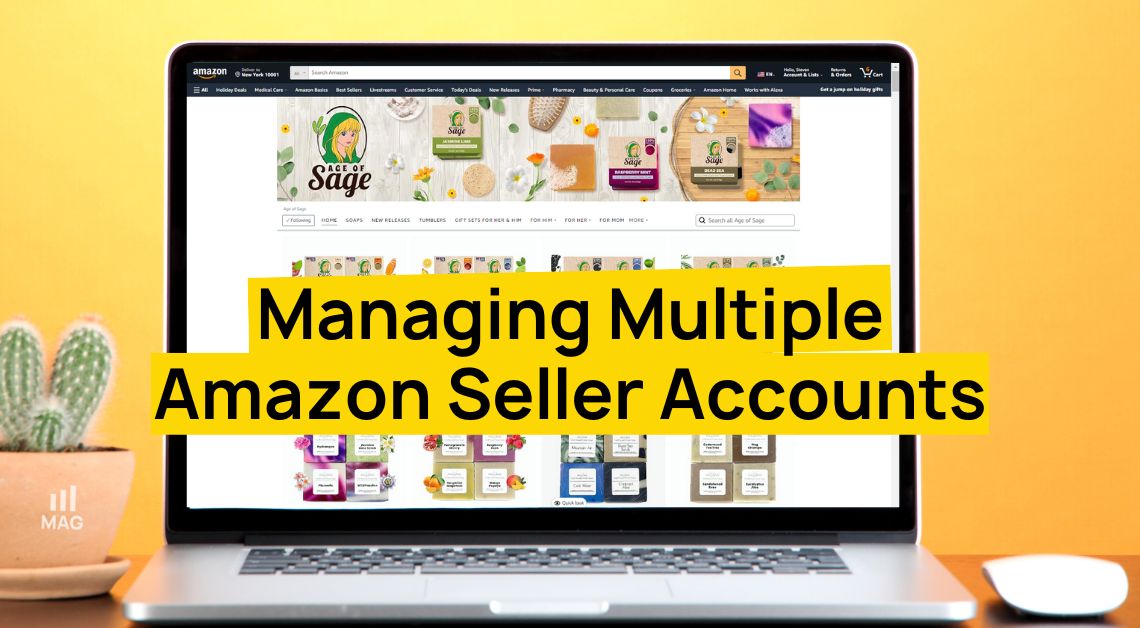A seller needs to be familiar with Amazon FBA shipping and logistics because it is a crucial aspect of running a successful business on the Amazon platform. Navigating this can feel like a maze, but we’ve prepared this blog post to guide you.
Amazon FBA Shipping and Logistics: Prepping, Packaging, Labeling
Prep and Packaging Requirements
Amazon does have specific guidelines for preparing items for FBA shipments based on the category or type of product. There are guidelines for loose products, items sold as set, products in perforated boxes, etc.
These guidelines ensure that the products are packaged and labeled correctly to meet Amazon’s requirements and ensure a smooth fulfillment process.
Based on the shipment checklist from Amazon FBA, below are the supplies you need to have when preparing a shipment.
Product and shipment
prep workstation
Printer (Amazon uses Zebra GX430t model printers with a direct thermal setting)
Scale for weighing boxes
Measuring tape to measure boxes
Printed copies of the Prep Matrix and Shipping Matrix
Amazon barcodes (printed from your account, if applicable)
Paper for packing slips Tape Dunnage (packing materials)
Boxes
Poly bags (at least 1.5 mils thick)
Opaque bags (adult products only)
Bubble wrap
“Sold as Set” or “Ready to Ship” labels
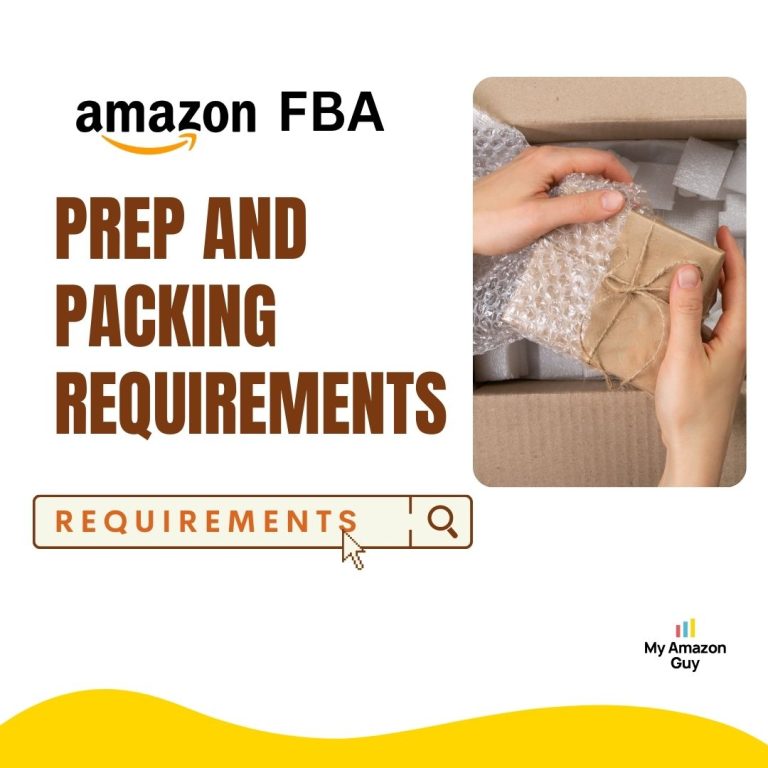
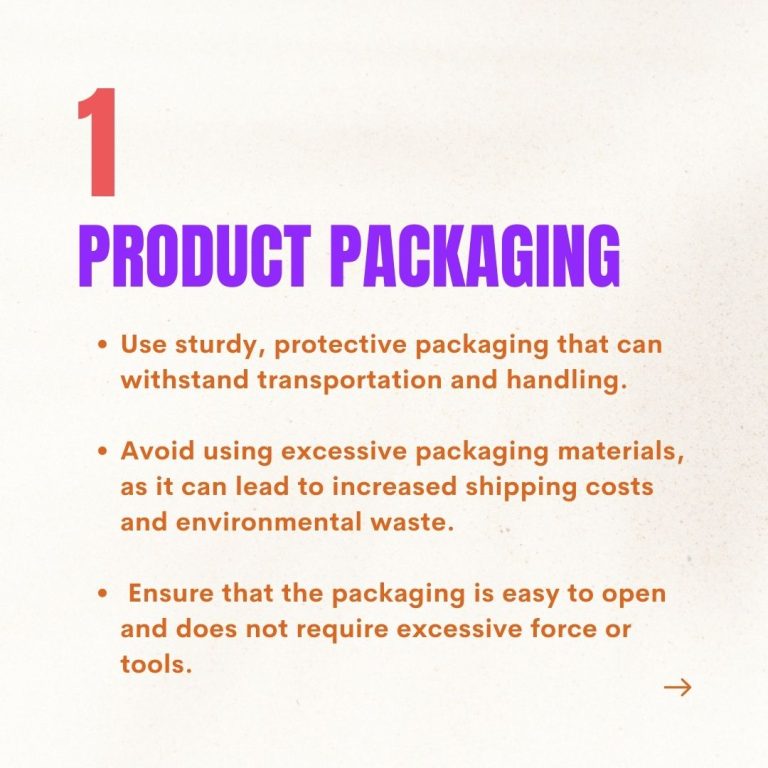
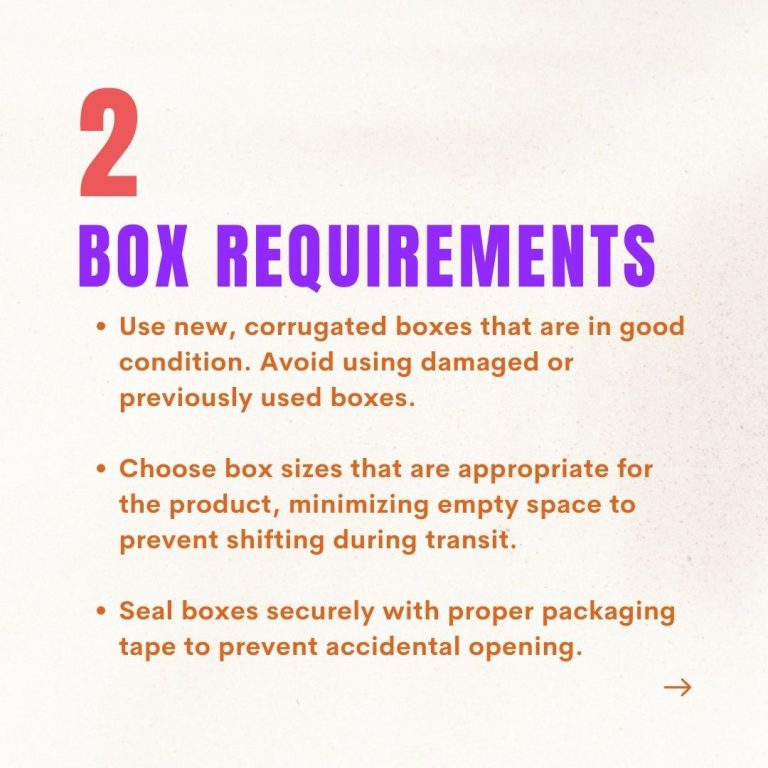
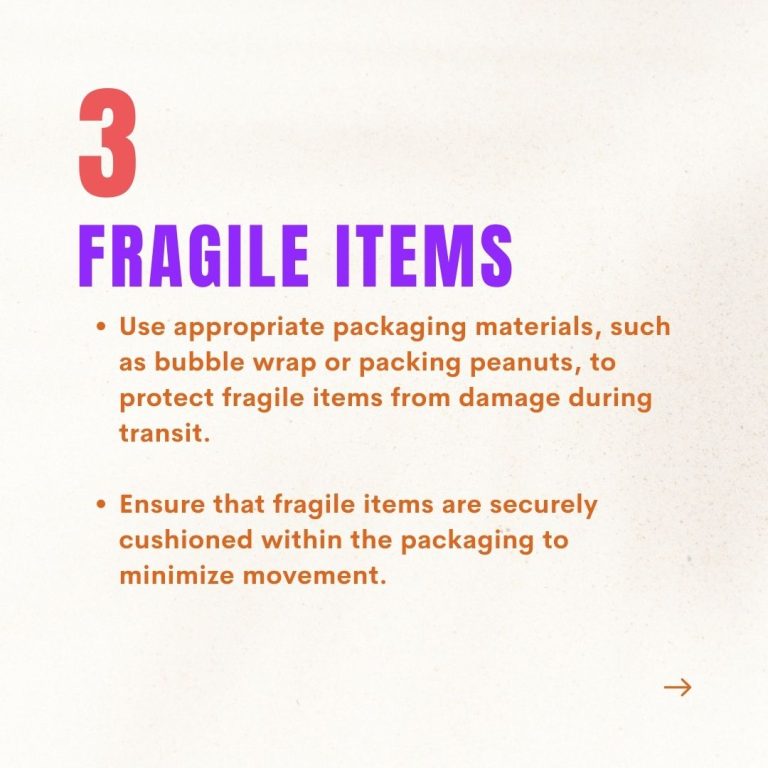
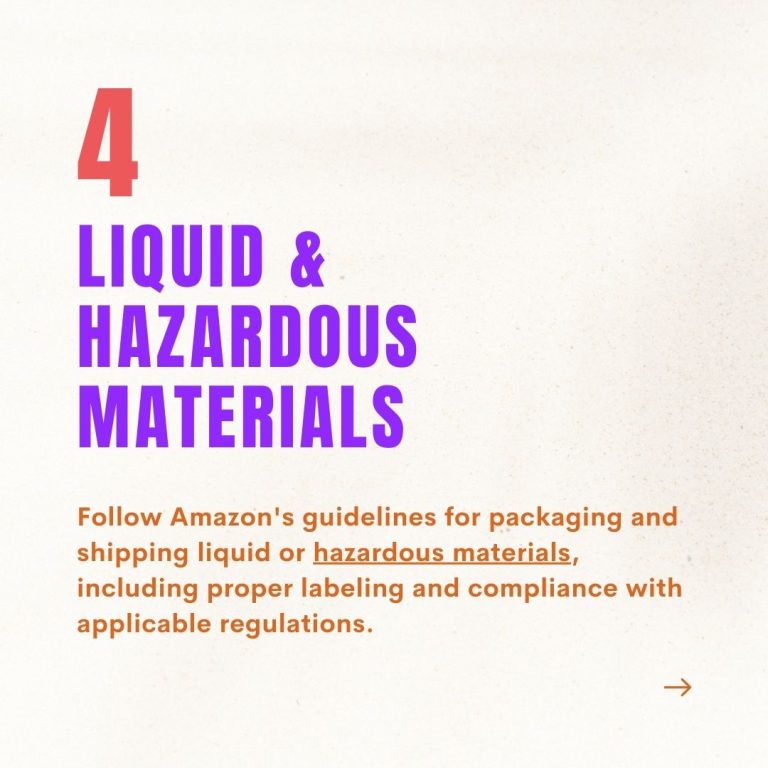
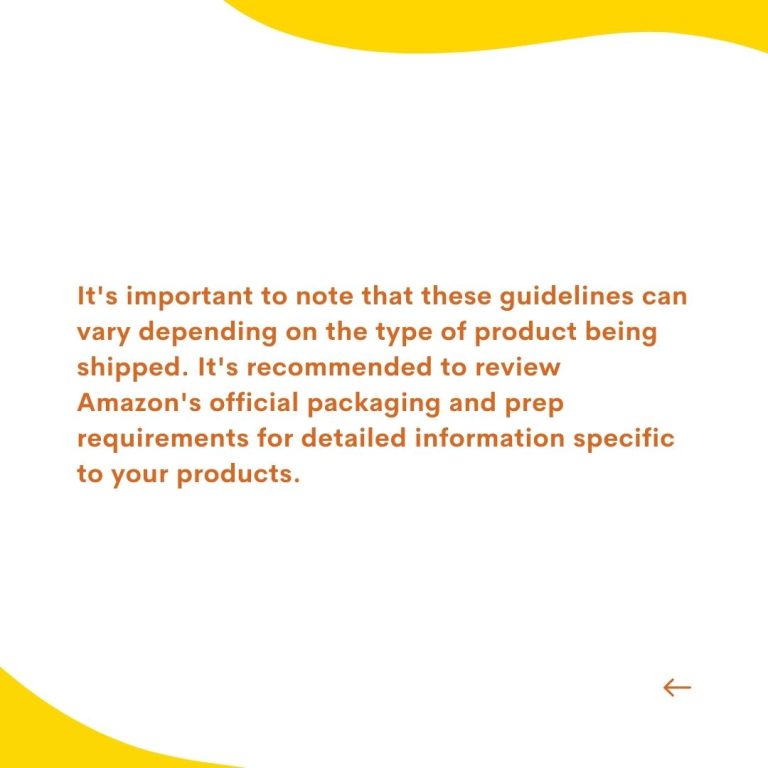
Labeling Requirements
Labeling guidelines for FBA shipments are an important aspect of preparing and shipping products to Amazon’s fulfillment centers. These guidelines ensure that products are properly identified and can be efficiently processed within Amazon’s logistics system. Here are some key labeling guidelines for FBA shipments:
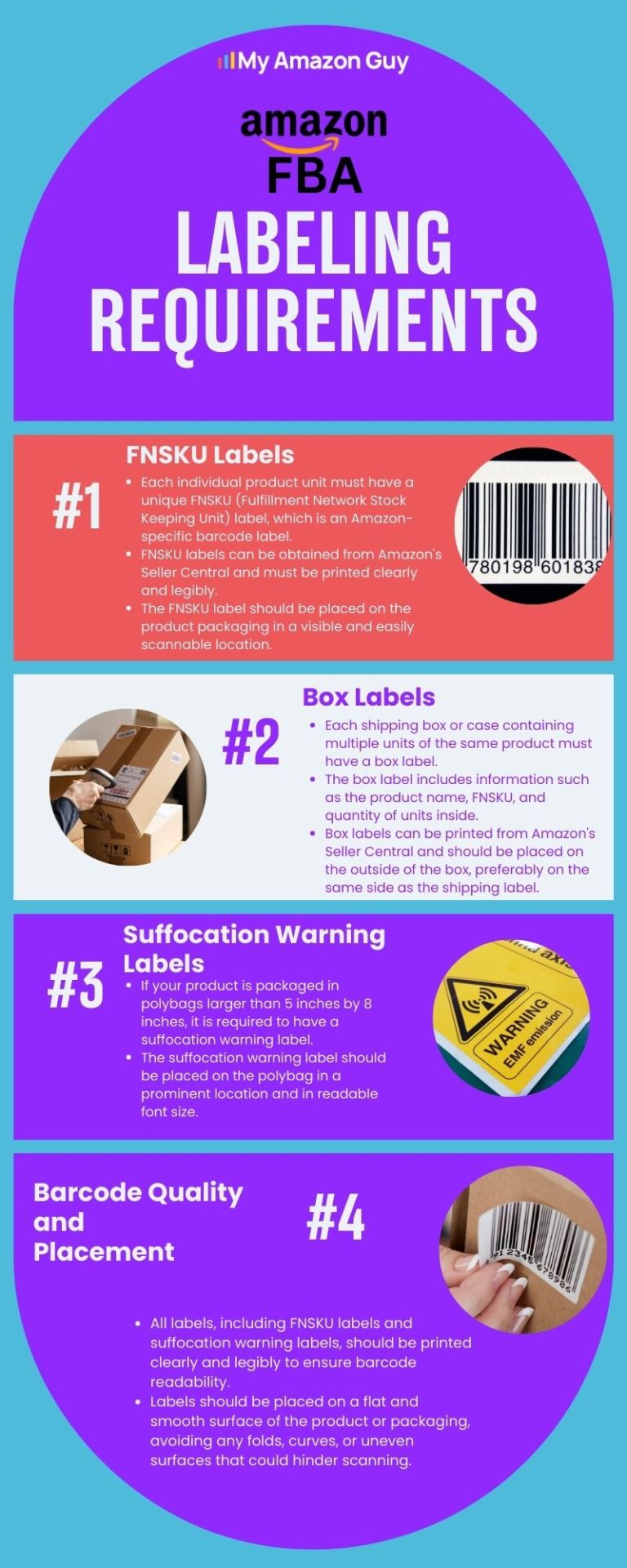
Shipping And Receiving Requirements
The FBA shipping and receiving requirements refer to the guidelines and procedures that sellers must follow when sending their products to Amazon’s fulfillment centers and receiving inventory into their FBA accounts. These requirements ensure that the fulfillment process is efficient and smooth. Here are some key FBA shipping and receiving requirements:
Shipping Plan Creation
- Sellers are required to create a shipping plan in Amazon’s Seller Central to notify Amazon about the products they will be sending.
- The shipping plan includes information such as the quantity of each product, the shipment origin, and the shipping carrier details.
Here’s a couple of My Amazon Guy’s videos on creating FBA shipment
Carrier Selection
- Sellers are responsible for selecting and arranging the shipping carrier to transport their products to Amazon’s fulfillment centers.
- It is recommended to use reliable carriers that provide tracking and insurance for the shipment.
Receiving Inventory
- Once the shipment arrives at the designated Amazon fulfillment center, Amazon’s warehouse staff will receive and process the inventory.
- The received inventory will go through quality checks and be placed into Amazon’s inventory system for fulfillment.
Compliance with Amazon's Policies
- Sellers must comply with Amazon’s policies and guidelines regarding prohibited products, restricted categories, and safety requirements.
- It is important to ensure that products are in compliance with all applicable laws and regulations.
Amazon FBA Shipping and Logistics: Inventory Management and Storage
Best practices for managing FBA inventory
Managing FBA inventory effectively is crucial for successful selling on Amazon. Here are some best practices to consider:
- Accurate Inventory Tracking:
Keep track of your inventory levels in realtime to avoid running out of stock or overselling.
Regularly reconcile your inventory with Amazon’s reports to ensure accuracy.
- Forecasting and Replenishment:
Use historical sales data and market trends to forecast demand and plan your inventory replenishment.
Set up automatic reorder alerts or use inventory management software to streamline the replenishment process.
- Optimize Product Listings:
Optimize your product listings with relevant keywords, compelling titles, clear and concise descriptions, and highquality images.
Regularly monitor and update your listings to improve visibility and conversion rates.
- Monitor Performance Metrics:
Keep a close eye on key performance metrics such as inventory turnover rate, days of inventory, and sellthrough rate.
Analyze these metrics to identify any inefficiencies or areas for improvement in your inventory management strategy.
- Utilize FBA Storage Options:
Take advantage of Amazon’s storage options, such as longterm storage, to optimize your inventory storage costs.
Use tools like the FBA Inventory Age report to identify slowmoving inventory and make informed decisions to prevent excess storage fees.
- Stay Compliant with Amazon’s Policies:
Adhere to Amazon’s policies and guidelines regarding product quality, condition, and safety to avoid potential issues or penalties.
Regularly review and update your inventory to remove any prohibited or restricted products.
- Efficient Return Management:
Have a clear process in place for handling customer returns and ensuring timely and accurate refunds or replacements.
Regularly assess returned inventory for potential resale or disposal to minimize losses.
- Regular Inventory Audits:
Conduct regular physical inventory audits to ensure accuracy and identify any discrepancies or potential issues.
Use inventory management software or barcode scanning tools for efficient and accurate audits
Strategies For Optimizing Storage Space In Amazon Warehouses
Dealing with excess inventory and long-term storage fees
If you have excess inventory on Amazon and want to avoid long-term storage fees, there are a few strategies you can consider.
First, you can lower the price of those items to encourage sales and get them moving. By offering a discounted price, you can attract more buyers and reduce the amount of excess inventory you have.
Another tactic is to create sponsored product ads to increase visibility and drive more traffic to your listings. This can help generate sales for your excess inventory and prevent it from accumulating further.
It’s also important to note that if an item hasn’t sold in six or more consecutive months and has been in an Amazon fulfillment center for over six months, Amazon will automatically start shipping it out. So, to avoid long-term storage fees, it’s crucial to ensure that your items have consistent sales every month.
Amazon FBA Shipping and Logistics: Shipping Methods and Carriers
Choosing the right shipping method for FBA shipments
Shipment Size and Weight:
- Evaluate the size and weight of your shipment. Smaller and lighter shipments may be more cost-effective to ship via small parcel carriers like UPS, FedEx, or USPS.
- For larger and heavier shipments, you might consider freight options such as Less Than Truckload (LTL) or Full Truckload (FTL) shipping.
Delivery Speed:
- Determine the desired delivery speed for your products. Expedited shipping methods like air freight or express carriers can deliver products quickly but may come at a higher cost.
- Standard shipping options like ground transportation may be more economical but have longer delivery times.
Cost Considerations:
- Compare the shipping rates and fees offered by different carriers or freight forwarders.
- Consider the overall cost, including transportation charges, fuel surcharges, accessorial fees, and any additional services required.
Destination and Distance:
- Consider the destination of your shipment and the distance it needs to travel. Some carriers may have better coverage or more competitive rates for specific regions or countries.
- Evaluate the transit time and reliability of carriers in delivering to your desired destinations.
Tracking and Insurance:
- Ensure that the chosen shipping method provides tracking capabilities to monitor the progress of your shipment.
- Consider the level of insurance coverage offered by the carrier to protect your products during transit.
Amazon’s Partnered Carrier Program:
- Amazon has a Partnered Carrier Program that offers discounted rates for FBA shipments.
- Evaluate if using Amazon’s partnered carriers aligns with your shipping requirements and provides cost savings.
Packaging Requirements:
- Consider the packaging requirements of your products. Some carriers may have specific packaging guidelines or restrictions that need to be followed.
Volume and Negotiation:
- If you have a high volume of shipments, you may have leverage to negotiate better rates with carriers or freight forwarders.
- Explore opportunities for consolidating shipments or using thirdparty logistics providers to optimize costs.
Questions To Ask When Comparing Shipping Rates And Services Of Different Carriers
When comparing shipping rates and services of different carriers, it’s important to ask the right questions to make an informed decision. Here are some key questions to consider:
- What are the shipping rates for my specific package size and weight?
– Obtain detailed pricing information for your specific shipment characteristics to compare costs accurately.
- Are there any additional fees or surcharges?
– Inquire about any additional charges, such as fuel surcharges, residential delivery fees, or accessorial fees, to understand the complete cost structure.
- What is the transit time for my shipment?
– Understand the estimated delivery timeframes offered by each carrier to ensure it aligns with your customer’s expectations.
- What is the coverage and reliability of the carrier?
– Assess the carrier’s track record in terms of on-time delivery, package handling, and overall service reliability.
- Do they provide package tracking and delivery confirmation?
– Confirm that the carrier offers tracking capabilities and delivery confirmation to keep both you and your customers informed about the shipment’s progress.
- What are the pickup and drop-off options?
– Determine if the carrier offers convenient pickup options, such as drop-off locations or scheduled pickups, that align with your operational requirements.
- Is insurance included or available for purchase?
– Inquire about the carrier’s insurance coverage options to protect your shipment in case of loss or damage during transit.
- What is their customer service like?
– Assess the carrier’s customer service reputation, responsiveness, and availability to address any inquiries or issues that may arise.
- Do they have any specific requirements or restrictions?
– Check if the carrier has specific packaging, labeling, or documentation requirements that need to be met for smooth and compliant shipping.
- Are there any volume discounts or negotiated rates available?
– Explore potential volume discounts or negotiated rates, especially if you anticipate a high shipping volume, to optimize costs.
Can I Negotiate Shipping Rates With Carriers For FBA Shipments?
Yes, it is possible to negotiate shipping rates with carriers for FBA (Fulfillment by Amazon) shipments, especially if you have a high shipping volume or can offer consistent business to the carrier. Here are some tips for negotiating shipping rates:
- Research and Compare:
– Before negotiating, research and compare rates from different carriers to have a clear understanding of the market rates and industry standards.
- Know Your Shipping Volume:
– Understand your shipping volume and be prepared to provide accurate data to the carriers. The higher your shipping volume, the more negotiating power you may have.
- Highlight Your Business Potential:
– Emphasize the potential for a long-term, mutually beneficial partnership. Highlight your growth plans and the potential for increased shipping volume in the future.
- Demonstrate Loyalty:
– If you have been consistently using a particular carrier for a significant amount of time, mention your loyalty and the value you have brought to their business.
- Leverage Multiple Carrier Options:
– Approach multiple carriers simultaneously and inform them that you are considering different options. This can create competition and incentivize carriers to offer better rates.
- Request Customized Quotes:
– Reach out to carrier representatives and request customized quotes based on your specific shipping needs. This allows you to compare and negotiate based on your unique requirements.
- Consider Additional Services:
– Look beyond just shipping rates and consider additional services that carriers may offer, such as tracking, insurance coverage, or value-added services. These can be negotiation points as well.
- Negotiate Contract Terms:
– Negotiate not only the shipping rates but also the terms of the contract, such as length, termination clauses, and any performance guarantees.
- Seek Professional Help:
– Consider working with a freight broker or a shipping consultant who specializes in negotiating carrier contracts. They may have existing relationships and expertise that can benefit your negotiations.
Amazon FBA Shipping and Logistics: International Shipping and Customs
Navigating international shipping requirements for FBA
When it comes to international shipping requirements for FBA (Fulfillment by Amazon), there are a few key things to keep in mind:
- Product Compliance: Ensure that your products comply with the regulations and restrictions of the destination country. This includes any specific labeling, packaging, or certification requirements.
- Customs Documentation: You will need to provide accurate and complete customs documentation, including commercial invoices, packing lists, and any other required forms. This information helps customs authorities assess duties, taxes, and import fees.
- Shipping Labels: Make sure to use the correct FBA shipping labels provided by Amazon. These labels include the FBA barcode and other necessary information for smooth processing and identification.
- Restricted Products: Certain products may have additional restrictions or regulations when it comes to international shipping. Familiarize yourself with Amazon’s policies and any country-specific restrictions to avoid any issues.
- Shipping Methods: Amazon offers different shipping methods for international shipments, including Amazon Global Selling, International Direct Fulfillment, and ExportX. Choose the shipping method that aligns with your business needs and budget.
- Duties and Taxes: Understand that duties, taxes, and import fees may apply to international shipments. It’s crucial to communicate these potential costs to your customers and ensure compliance with local tax regulations.
Optimizing international shipping costs and delivery times
- Evaluate shipping carriers: Research and compare different shipping carriers to find the most cost-effective and reliable options for international shipments. Consider factors such as shipping rates, delivery times, tracking capabilities, and customer reviews.
- Utilize fulfillment centers: Fulfillment centers can help streamline international shipping by storing and shipping your products from local warehouses in different countries. This can reduce shipping costs and delivery times by eliminating the need for long-distance international shipping.
- Optimize packaging: Efficient packaging can help reduce shipping costs by minimizing the weight and size of each package. Consider using lightweight and compact packaging materials without compromising product safety.
- Leverage international shipping programs: Amazon offers programs like Amazon Global Selling and Fulfillment by Amazon (FBA) to help sellers expand their reach and simplify international shipping. These programs provide access to Amazon’s global customer base and take care of shipping logistics.
- Consider customs and import regulations: Familiarize yourself with the customs and import regulations of each country you plan to ship to. This will help avoid any delays or additional costs associated with customs clearance.
- Offer multiple shipping options: Similar to domestic shipping, offering a range of shipping options for international customers can cater to different preferences and urgency levels. This may include standard shipping, expedited shipping, and even premium shipping options.
- Reduce delivery times: Efficient order processing and fulfillment can help hasten delivery times. Ensure you have streamlined processes in place to handle international orders promptly and accurately.
Watch this video playlist to earn more about International Shipping
Amazon FBA Shipping and Logistics: Returns and Reverse Logistics
Handling customer returns through FBA
Here’s a general overview of how customer returns are handled:
- Customer Initiated Return: When a customer wants to return a product they purchased through FBA, they can initiate the return process through their Amazon account. They will select the reason for the return and choose a return shipping method.
- Return Authorization: Once the customer initiates the return, Amazon will review and authorize the return request. They will determine if the return is eligible based on Amazon’s return policy.
- Return Shipping Label: Amazon will generate a return shipping label for the customer to use when sending the product back. The label is usually pre-paid by Amazon, although there may be some cases where the customer is responsible for the return shipping cost.
- Return Shipment: The customer will package the product securely and attach the provided return shipping label. They will then ship the product back to the designated Amazon fulfillment center.
- Return Processing: Once the returned product arrives at the fulfillment center, Amazon will inspect and process the return. They will determine if the product is in sellable condition or if it needs to be disposed of or returned to the seller.
- Seller Reimbursement: If the returned product is determined to be in sellable condition, Amazon may reimburse the seller for the return. The reimbursement is typically based on the item’s original selling price minus any applicable fees.
It’s important to note that the specific details of the return process may vary depending on the circumstances and Amazon’s policies at the time. Sellers can monitor and manage their customer returns through their Seller Central account, where they can access return reports and communicate with customers if necessary.
Here is a video from Steven Pope, founder of My Amazon Guy, to teach you how to track FBA product returns in Seller Central
Strategies for minimizing returns and improving customer satisfaction
To minimize returns and improve customer satisfaction, here are some strategies that can help.
- Accurate Product Descriptions: Provide detailed and accurate product descriptions, including dimensions, materials, features, and any potential limitations. This helps set proper expectations and reduces the likelihood of customers receiving products that don’t meet their needs.
- Clear and High-Quality Product Images: Use high-resolution images that accurately represent your products. Show multiple angles, close-ups, and include any relevant details. This helps customers make informed purchase decisions and reduces the chance of dissatisfaction upon receiving the product.
- Effective Customer Communication: Promptly respond to customer inquiries and messages to address any concerns or questions they may have. Clear and timely communication can help resolve issues before they escalate and potentially lead to a return.
- Quality Control and Inspection: Implement robust quality control measures to ensure that products are thoroughly inspected before shipping. This helps minimize the chances of customers receiving defective or damaged items.
- Accurate Sizing and Fit Information: For apparel or products with size variations, provide detailed sizing charts and fit information. This helps customers choose the right size and reduces the likelihood of returns due to sizing issues.
- Reliable Packaging: Use sturdy and protective packaging materials to minimize the risk of products being damaged during transit. Properly secure and cushion fragile items to reduce the chances of returns due to shipping-related damages.
- Customer Reviews and Feedback: Encourage satisfied customers to leave positive reviews and feedback. This can instill confidence in potential buyers and help them make informed purchase decisions, reducing the likelihood of returns.
- Streamlined Return Process: Make the return process as smooth and hassle-free as possible for customers. Provide clear instructions, a simple return policy, and prompt refunds or replacements when necessary. A positive return experience can enhance customer satisfaction.
- Continuous Improvement: Regularly analyze return patterns and customer feedback to identify recurring issues or trends. Use this information to make improvements to product quality, packaging, or customer service processes.
Amazon FBA Shipping and Logistics: Inventory Replenishment and Forecasting
Forecasting demand and calculating optimal inventory levels for FBA
Forecasting demand and calculating optimal inventory levels for FBA (Fulfillment by Amazon) is crucial for maintaining a healthy supply chain and avoiding stockouts or excess inventory.
- Historical Sales Data: Analyze your historical sales data to identify patterns and trends. Look for seasonality, peak periods, or any other factors that may influence demand for your products.
- Market Research: Stay updated on market trends, industry developments, and competitor analysis. This can provide insights into potential changes in demand and help you adjust your inventory levels accordingly.
- Sales Velocity: Calculate your sales velocity by dividing the number of units sold within a specific time period by the number of days in that period. This metric helps you understand the rate at which your inventory is moving and can guide your replenishment decisions.
- Lead Time: Consider the lead time required to restock inventory. Take into account the time it takes for your supplier to deliver the products to Amazon’s fulfillment centers. This will help you plan ahead and avoid stockouts.
- Reorder Point: Determine your reorder point, which is the inventory level at which you should place a new order to replenish stock. It is calculated by considering factors such as lead time, sales velocity, and desired safety stock level.
- Safety Stock: Set aside a safety stock to act as a buffer against unexpected spikes in demand or delays in replenishment. The amount of safety stock you maintain depends on factors like lead time variability, demand variability, and acceptable risk levels.
- FBA Inventory Performance: Monitor your FBA inventory performance metrics through Amazon’s Seller Central. This includes metrics like Inventory Performance Index (IPI), excess inventory, and stranded inventory. These metrics can provide insights into inventory health and help you optimize your inventory levels.
- Use Inventory Management Tools: Utilize inventory management tools or software that can help you automate the demand forecasting and inventory planning process. These tools can analyze historical data, factor in lead times, and generate optimal replenishment recommendations.
Replenishing inventory efficiently to avoid stockouts and oversupply
Oversupply can lead to increased storage fees and tie up your capital, while stockouts can decrease your sales rank and visibility on Amazon. Hence, you need to efficiently replenish your inventory through:
- Demand Forecasting: Utilize historical sales data, market research, and industry trends to forecast future demand for your products. This will help you estimate how much inventory you need to have on hand to meet customer demand without experiencing stockouts or oversupply.
- Lead Time Management: Consider the lead time required to restock inventory. Keep track of the time it takes for your supplier to deliver products to Amazon’s fulfillment centers. By factoring in lead time, you can place reorders in advance to avoid stockouts.
- Reorder Point: Determine your reorder point, which is the inventory level at which you should place a new order. It is typically calculated based on factors such as lead time, sales velocity, and desired safety stock level. Reordering at the right time ensures that you have sufficient inventory without overstocking.
- Safety Stock: Maintain a safety stock to act as a buffer against unexpected fluctuations in demand or delays in replenishment. The amount of safety stock you hold depends on factors like lead time variability, demand variability, and acceptable risk levels. It helps prevent stockouts during unforeseen circumstances.
- Inventory Turnover: Monitor your inventory turnover rate, which is the number of times inventory is sold and replenished within a specific time period. Aim for an optimal balance between having enough inventory to meet demand and avoiding excess inventory. Higher inventory turnover indicates more efficient inventory management.
- Just-in-Time (JIT) Inventory: Consider implementing a just-in-time inventory strategy, where you order inventory to arrive just in time for anticipated sales. This approach minimizes the amount of inventory you need to store, reduces holding costs, and helps avoid oversupply.
- Communication with Suppliers: Maintain open and effective communication with your suppliers. Keep them informed about your inventory needs and any changes in demand. This helps ensure timely deliveries and minimizes the risk of stockouts or delays.
- Utilize Inventory Management Tools: Leverage inventory management tools or software that can automate and streamline the replenishment process. These tools can help analyze sales data, calculate reorder points, and provide insights into optimal inventory levels.
What Amazon's inventory management tools and reports can I use for better forecasting?
- Amazon Selling Coach: This tool provides personalized recommendations and guidance based on your sales history and performance. It can help you identify opportunities to optimize your inventory levels and improve forecasting accuracy.
- Inventory Performance Dashboard: This dashboard provides an overview of your inventory health and performance. It includes metrics such as Inventory Performance Index (IPI), excess inventory, stranded inventory, and sell-through rate. It helps you identify areas for improvement and optimize your inventory levels.
- FBA Inventory Age: This report shows the age of your FBA inventory, helping you identify slow-moving or stagnant inventory. By addressing aged inventory, you can prevent overstocking and improve cash flow.
- FBA Inventory Reconciliation: This report helps reconcile discrepancies between your inventory and Amazon’s records. It identifies issues such as lost or damaged inventory, which can impact your forecasting accuracy and inventory management.
- Sales Dashboard: The Sales Dashboard provides insights into your sales performance, including order trends, top-selling products, and sales velocity. Analyzing this data can help you forecast demand more accurately.
- Business Reports: Amazon provides various business reports, including the Detailed Page Sales and Traffic report, which provides data on product views, conversions, and sales by ASIN. These reports can help you identify trends and patterns in customer behavior, aiding in demand forecasting.
- Advertising Reports: Amazon’s advertising reports, such as the Search Term Report and Advertising Cost of Sales (ACoS) report, provide insights into your advertising campaigns. By understanding the impact of your advertising efforts on sales, you can adjust your inventory levels accordingly.
Want to know more about inventory management? Then here are a few more videos to watch
Amazon FBA Shipping and Logistics: Random Q&As
Does FBA Require Pallets?
No, FBA does not require pallets for every shipment. Whether or not pallets are needed depends on the size and weight of the shipment. Smaller shipments can be sent without pallets, while larger and heavier shipments may require palletization for ease of handling and transportation.
Are there requirements for shipping palletized inventory to Amazon FBA?
Some of the key requirements include properly labeling the pallets, using sturdy and compliant pallets, and ensuring that the pallets are properly wrapped and secured for transportation.
How big of a box can you ship to Amazon FBA?
The maximum box size for Amazon shipping without incurring additional fees is 25 inches long. If a box is longer than 25 inches, a fee of 25 dollars will be charged by Amazon.
Can I use Lowes boxes for Amazon FBA?
Yes, you can use Lowes boxes for Amazon FBA as long as they meet Amazon’s packaging guidelines and requirements for safe and secure shipment. It is recommended to use new, sturdy boxes that can withstand the rigors of transportation to ensure the protection of your products.
Can you use UHaul boxes for Amazon FBA?
You can use U-Haul boxes for Amazon FBA as long as they meet the packaging requirements outlined by Amazon, such as being sturdy and properly sealed. It is important to ensure that the boxes are in good condition and can protect the products during transit.
How do I send large items to Amazon FBA?
To send large items to Amazon FBA, you will need to create a shipping plan in Seller Central, select “LTL” (Less Than Truckload) as the shipment type, and provide the necessary information such as pallet information, estimated freight class, and declared value for the products being shipped. Once the shipment is approved, you can print out the box and pallet labels and send them to Amazon.
Can I pack multiple items when shipping to Amazon FBA?
Yes, you can pack multiple items when shipping to Amazon FBA. However, the maximum quantity per box is limited to 150 due to weight constraints, although there might be a possibility of sending more if the items are super small.
Do you have to pay for inventory on Amazon FBA?
Yes, as a seller using Amazon FBA (Fulfillment by Amazon), you are responsible for purchasing and providing the inventory that you want to sell on the platform. Amazon charges fees for storage and fulfillment services related to your inventory.
Do polybags have to be clear for FBA?
Yes, polybags for FBA do need to be clear. Amazon requires polybags to be transparent so that the contents can be easily identified and inspected.
Is Amazon FBA logistics?
Yes, Amazon FBA (Fulfillment by Amazon) is a logistics service provided by Amazon where sellers can store their products in Amazon’s fulfillment centers. Amazon takes care of the packaging, shipping, and customer service for these products, allowing sellers to focus on other aspects of their business.
Conclusion
Being familiar with Amazon FBA shipping and logistics is crucial for running a successful e-commerce business on the platform. It helps you streamline operations, improve customer satisfaction, and maximize your sales potential.



